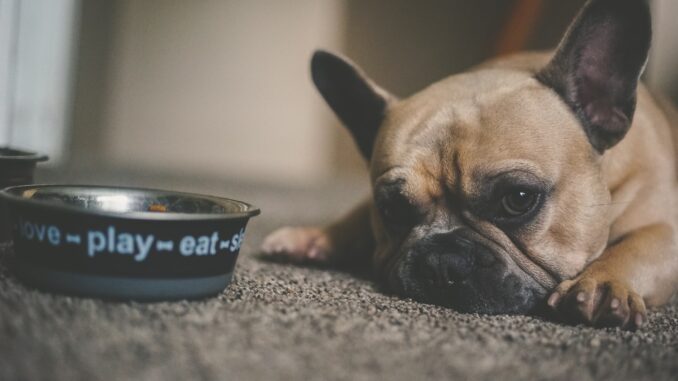
This article was updated on August 18th, 2022
Your situation:
✓ your dog has not eaten for 2-3 days or more
✓ your dog is not showing other obvious signs of illness
(If this is NOT your situation, click here.)
Normally, your dog has a big appetite. But now, your dog hasn’t eaten for a while.
During mealtimes, they lick their bowl clean. But lately you have noticed the kibble goes untouched. Even the yummy raw food and wet toppings get ignored. In fact, come to think of it, your dog hasn’t eaten for 2 or 3 days.
What should you do?
The first step is to remain calm. There are a dozen different reasons why a dog – from puppy to senior – might turn their nose up at food. The information below will help owners understand why their dogs isn’t eating for 2 or 3 days and also offer tried and true suggestions regarding what to do about it.
Ready? Let’s dive in.
Most Common Reasons Your Dog Hasn’t Eaten in Over 2 Days
“What’s the matter, girl? Why aren’t you eating your dinner?” This phrase might sound familiar if you have ever been faced with a dog who decides to skip a meal. A dog who refuses to eat might be doing so for any number of reasons. For example, they could be tired. Or have lost their appetite temporarily due to the hot/cold weather. In addition, pups who feel stressed, anxious, or fearful may not be in the mood to gobble down a bowl of food – no matter how yummy it is.
These are common reasons why a dog might suddenly stop eating for 24 hours.
However, if your dog hasn’t eaten in 2 or 3 days, then the cause is more likely of physical origin. The following are often the culprits behind a pooch’s involuntary 48+ hour hunger strike.
1. Gastroenteritis
When a dog’s stomach and intestines become inflamed from bacteria, medications, parasites, food sensitives/allergies, etc. gastroenteritis can result. This is an acute illness which (much to pet parents’ relief!) generally clears up on its own within 1 week.
Unfortunately, during that time a dog might experience symptoms such as abdominal pain, nausea, vomiting, and diarrhea…No wonder they aren’t feeling hungry!
2. Pancreatitis
When it comes to decreased appetite, be mindful of pancreatitis. This condition occurs when the pancreas organ in a dog’s body becomes inflamed. A pup with mild pancreatitis might act lethargically, feel weak, be at risk for dehydration, and stop eating for 2 or more days.
3. Obstruction
A third common reason why a dog shows zero interest in meals has to do with the possibility of an obstruction somewhere. This is a scary medical condition that can be life threatening. If water and food cannot properly pass through the stomach or intestines for 3 – 7 days, two things happen.
First, your dog doesn’t get any nourishment.
Second, the intestinal wall might rupture…and they die. Therefore, always treat a suspected obstruction as an emergency situation!
4. Dental Problems
Is your puppy losing their baby teeth? Does your dog have cavities or maybe an oral infection? Dental problems can lead to mouth soreness and pain, which makes chewing uncomfortable.
My Dog Hasn’t Eaten in Days. When Should I Call the Vet?
Of course, it’s upsetting to see our pets feeling unwell.
Fluctuating appetites are normal. But in terms of when to worry, it all boils down to a) how long the dog has gone without food and b) what other medical symptoms they are presenting.
When in doubt, call your veterinarian for advice.
Generally speaking, 3 days is the max. Any longer, and a dog showing no signs of improvement should be seen by a vet for an examination and diagnosis. Technically speaking, dogs can survive for many days without food, but waiting too long is both dangerous and unkind.
Oh, and one very important final note!
Your dog should still be drinking water. If they neither eat nor drink at all within 24 hours, it’s time book an appointment ASAP. Just like humans, dogs can go longer without food than they can water.
Steps to Take at Home When Your Dog Hasn’t Eaten
To encourage a dog to at least get some bites of food in their stomach, owners have a couple of options. To start, don’t force feed your dog. Leave food out and make it easily accessible. Chances are, once your pooch feels a little better, they will naturally start eating again. You can also find a few actionable tips by reading our article below with Tips from the Vet to Get Your Old Dog To Eat More.
While it can be worrisome when a dog hasn’t eaten for 2 or 3 days, knowing what to look for and how to respond will bring relief to both you, and your dog!
Disclaimer: This website's content is not a substitute for veterinary care. Always consult with your veterinarian for healthcare decisions. Read More.


Be the first to comment